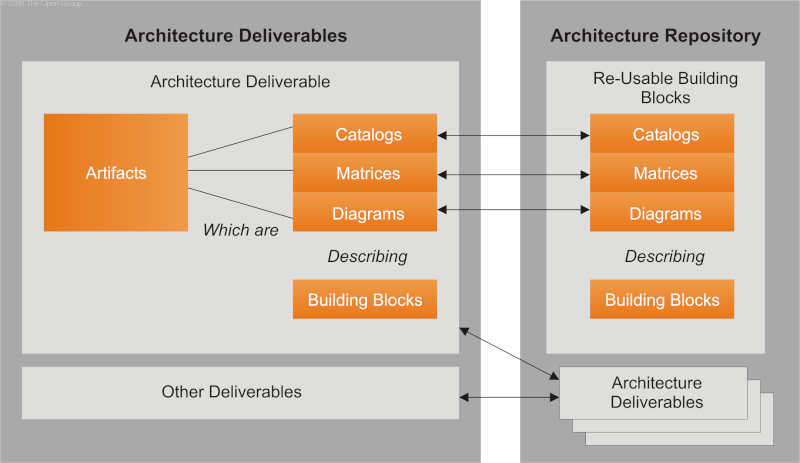
| You are here: | ||
| <<< Previous | Home | Next >>> |
For the purposes of TOGAF 9, the core concepts provided in this chapter apply.
TOGAF is an architecture framework - The Open Group Architecture Framework. TOGAF provides the methods and tools for assisting in the acceptance, production, use, and maintenance of an enterprise architecture. It is based on an iterative process model supported by best practices and a re-usable set of existing architecture assets.
ISO/IEC 42010:2007 defines "architecture" as:
"The fundamental organization of a system, embodied in its components, their relationships to each other and the environment, and the principles governing its design and evolution."
TOGAF embraces but does not strictly adhere to ISO/IEC 42010:2007 terminology. In TOGAF, "architecture" has two meanings depending upon the context:
In TOGAF we endeavor to strike a balance between promoting the concepts and terminology of ISO/IEC 42010:2007 - ensuring that our usage of terms defined by ISO/IEC 42010:2007 is consistent with the standard - and retaining other commonly accepted terminology that is familiar to the majority of the TOGAF readership. For more on terminology, refer to 3. Definitions and Part IV, 35. Architectural Artifacts .
There are four architecture domains that are commonly accepted as subsets of an overall enterprise architecture, all of which TOGAF is designed to support:
The TOGAF Architecture Development Method (ADM) provides a tested and repeatable process for developing architectures. The ADM includes establishing an architecture framework, developing architecture content, transitioning, and governing the realization of architectures.
All of these activities are carried out within an iterative cycle of continuous architecture definition and realization that allows organizations to transform their enterprises in a controlled manner in response to business goals and opportunities.
Phases within the ADM are as follows:
Architects executing the ADM will produce a number of outputs as a result of their efforts, such as process flows, architectural requirements, project plans, project compliance assessments, etc. The TOGAF Architecture Content Framework (see Part IV, 33. Introduction) provides a structural model for architectural content that allows major work products to be consistently defined, structured, and presented.
The Architecture Content Framework uses the following three categories to describe the type of architectural work product within the context of use:
Building blocks can be defined at various levels of detail, depending on what stage of architecture development has been reached. For instance, at an early stage, a building block can simply consist of a name or an outline description. Later on, a building block may be decomposed into multiple supporting building blocks and may be accompanied by a full specification. Building blocks can relate to "architectures" or "solutions".
The relationships between deliverables, artifacts, and building blocks are shown in Relationships between Deliverables, Artifacts, and Building Blocks .

For example, an Architecture Definition Document is a deliverable that documents an architecture description. This document will contain a number of complementary artifacts that are views of the building blocks relevant to the architecture. For example, a process flow diagram (an artifact) may be created to describe the target call handling process (a building block). This artifact may also describe other building blocks, such as the actors involved in the process (e.g., a Customer Services Representative). An example of the relationships between deliverables, artifacts, and building blocks is illustrated in Example - Architecture Definition Document .
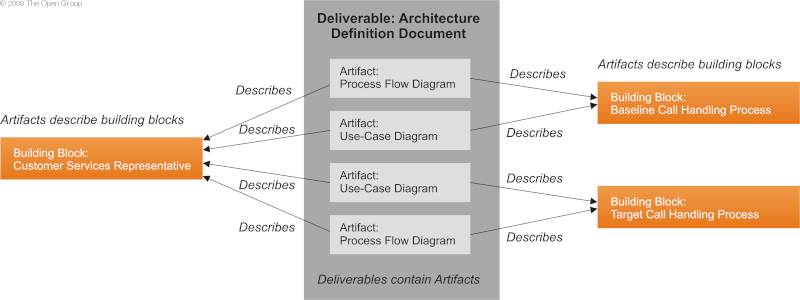
TOGAF includes the concept of the Enterprise Continuum, which sets the broader context for an architect and explains how generic solutions can be leveraged and specialized in order to support the requirements of an individual organization. The Enterprise Continuum is a view of the Architecture Repository that provides methods for classifying architecture and solution artifacts as they evolve from generic Foundation Architectures to Organization-Specific Architectures. The Enterprise Continuum comprises two complementary concepts: the Architecture Continuum and the Solutions Continuum.
An overview of the structure and context for the Enterprise Continuum is shown in Enterprise Continuum .
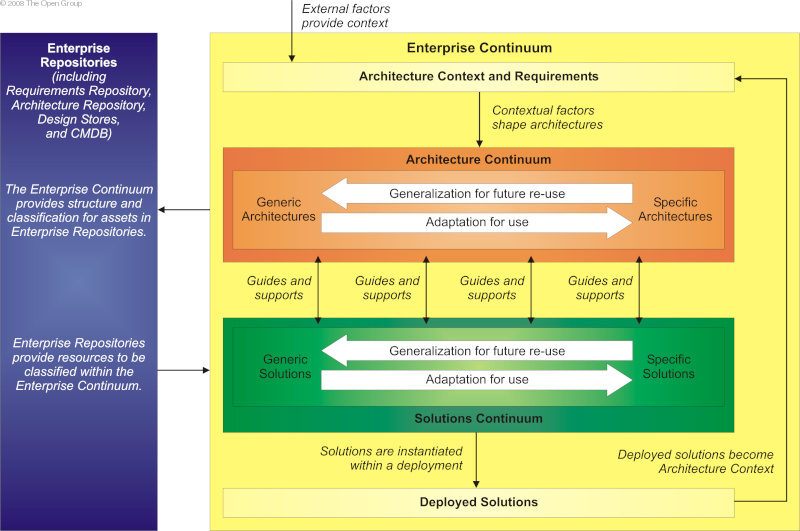
Supporting the Enterprise Continuum is the concept of an Architecture Repository which can be used to store different classes of architectural output at different levels of abstraction, created by the ADM. In this way, TOGAF facilitates understanding and co-operation between stakeholders and practitioners at different levels.
By means of the Enterprise Continuum and Architecture Repository, architects are encouraged to leverage all other relevant architectural resources and assets in developing an Organization-Specific Architecture.
In this context, the TOGAF ADM can be regarded as describing a process lifecycle that operates at multiple levels within the organization, operating within a holistic governance framework and producing aligned outputs that reside in an Architecture Repository. The Enterprise Continuum provides a valuable context for understanding architectural models: it shows building blocks and their relationships to each other, and the constraints and requirements on a cycle of architecture development.
The structure of the TOGAF Architecture Repository is shown in TOGAF Architecture Repository Structure .
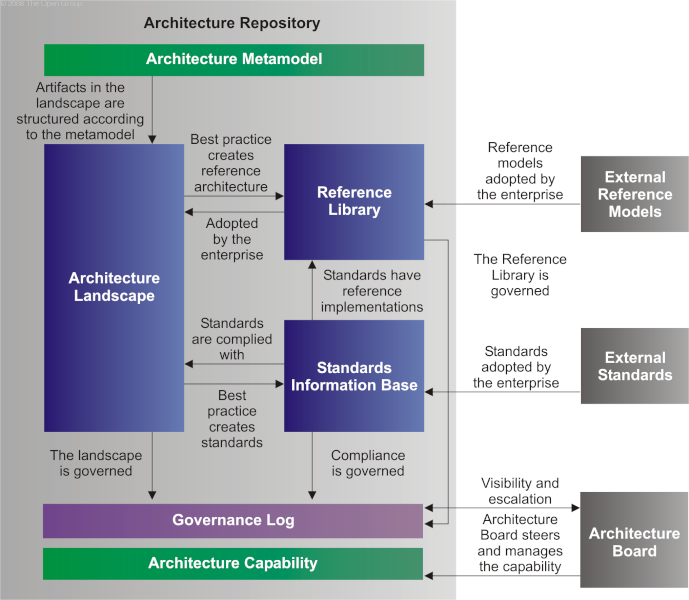
The major components within an Architecture Repository are as follows:
In order to carry out architectural activity effectively within an enterprise, it is necessary to put in place an appropriate business capability for architecture, through organization structures, roles, responsibilities, skills, and processes. An overview of the TOGAF architecture capability is shown in TOGAF Architecture Capability Overview .
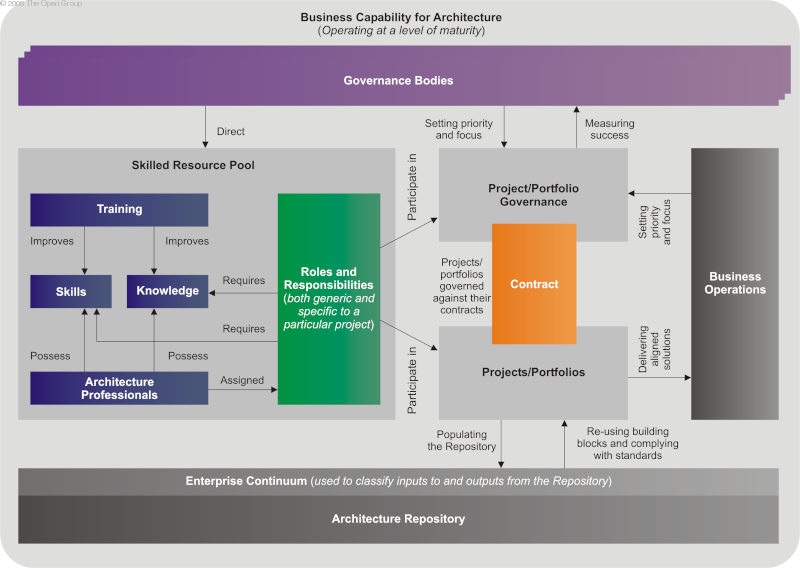
Barring architecture capabilities set up to purely support change delivery programs, it is increasingly recognized that a successful enterprise architecture practice must sit on a firm operational footing. In effect, an enterprise architecture practice must be run like any other operational unit within a business; i.e., it should be treated like a business. To this end, and over and above the core processes defined within the ADM, an enterprise architecture practice should establish capabilities in the following areas:
Central to the notion of operating an ongoing architecture is the execution of well-defined and effective governance, whereby all architecturally significant activity is controlled and aligned within a single framework.
As governance has become an increasingly visible requirement for organizational management, the inclusion of governance within TOGAF aligns the framework with current business best practice and also ensures a level of visibility, guidance, and control that will support all architecture stakeholder requirements and obligations.
The benefits of architecture governance include:
Further detail on establishing an enterprise architecture capability is given in Part VII, 45. Introduction .
Two of the key elements of any enterprise architecture framework are:
With some exceptions, the majority of enterprise architecture frameworks focus on the first of these - the specific set of deliverables - and are relatively silent about the methods to be used to generate them (intentionally so, in some cases).
Because TOGAF is a generic framework and intended to be used in a wide variety of environments, it provides a flexible and extensible content framework that underpins a set of generic architecture deliverables.
As a result, TOGAF may be used either in its own right, with the generic deliverables that it describes; or else these deliverables may be replaced or extended by a more specific set, defined in any other framework that the architect considers relevant.
In all cases, it is expected that the architect will adapt and build on the TOGAF framework in order to define a tailored method that is integrated into the processes and organization structures of the enterprise. This architecture tailoring may include adopting elements from other architecture frameworks, or integrating TOGAF methods with other standard frameworks, such as ITIL, CMMI, COBIT, PRINCE2, PMBOK, and MSP. Guidelines for adapting the TOGAF ADM in such a way are given in Part II, 5.3 Adapting the ADM .
As a generic framework and method for enterprise architecture, TOGAF also complements other frameworks that are aimed at specific vertical business domains, specific horizontal technology areas (such as security or manageability), or specific application areas (such as e-Commerce).
A TOGAF document categorization model exists to structure the release management of the TOGAF specification. It is not intended to serve as an implementation guide for practitioners.
Within the model, the content of the TOGAF document is categorized according to the following four categories:
The following table maps the content of this document to the four categories.
|
Section |
Category |
Comments |
|
|---|---|---|---|
|
|
Preface |
TOGAF Mandated |
|
|
|
|
|
|
|
1 |
Introduction |
|
|
|
1.1 |
Structure of the TOGAF Document |
TOGAF Core |
|
|
1.2 |
Executive Overview |
TOGAF Core |
|
|
2 |
Core Concepts |
TOGAF Core |
|
|
3 |
Definitions |
TOGAF Mandated |
|
|
4 |
Release Notes |
TOGAF Supporting |
|
|
|
Part II: Architecture Development Method |
|
|
|
5 |
Introduction |
|
|
|
5.1 |
ADM Overview |
|
|
|
5.1.1 |
The ADM, Enterprise Continuum, and Architecture Repository |
TOGAF Mandated |
|
|
5.1.2 |
The ADM and the Foundation Architecture |
TOGAF Recommended |
|
|
5.1.3 |
ADM and Supporting Guidelines & Techniques |
TOGAF Supporting |
|
|
5.2 |
Architecture Development Cycle |
|
|
|
5.2.1 |
Key Points |
TOGAF Core |
|
|
5.2.2 |
Basic Structure |
TOGAF Core |
|
|
5.3 |
Adapting the ADM |
TOGAF Mandated |
|
|
5.4 |
Architecture Governance |
TOGAF Recommended |
|
|
5.5 |
Scoping the Architecture |
TOGAF Core |
Concepts of scoping are Core; specific ways are Recommended. |
|
5.5.1 |
Enterprise Scope/Focus |
TOGAF Recommended |
|
|
5.5.2 |
Architecture Domains |
TOGAF Core |
|
|
5.5.3 |
Vertical Scope/Level of Detail |
TOGAF Recommended |
|
|
5.5.4 |
Time Period |
TOGAF Recommended |
|
|
5.6 |
Architecture Integration |
TOGAF Recommended |
|
|
5.7 |
Summary |
TOGAF Supporting |
|
|
6 |
Preliminary Phase |
|
|
|
6.1 |
Objectives |
TOGAF Mandated |
|
|
6.2 |
Approach |
TOGAF Recommended |
|
|
6.3 |
Inputs |
TOGAF Mandated |
|
|
6.4 |
Steps |
TOGAF Mandated |
|
|
6.5 |
Outputs |
TOGAF Mandated |
|
|
7 |
Phase A: Architecture Vision |
|
|
|
7.1 |
Objectives |
TOGAF Mandated |
|
|
7.2 |
Approach |
TOGAF Recommended |
|
|
7.3 |
Inputs |
TOGAF Mandated |
|
|
7.4 |
Steps |
TOGAF Mandated |
|
|
7.5 |
Outputs |
TOGAF Mandated |
|
|
8 |
Phase B: Business Architecture |
|
|
|
8.1 |
Objectives |
TOGAF Mandated |
|
|
8.2 |
Approach |
TOGAF Recommended |
|
|
8.3 |
Inputs |
TOGAF Mandated |
|
|
8.4 |
Steps |
TOGAF Mandated |
|
|
8.5 |
Outputs |
TOGAF Mandated |
|
|
9 |
Phase C: Information Systems Architectures |
|
|
|
9.1 |
Objectives |
TOGAF Mandated |
|
|
9.2 |
Approach |
TOGAF Recommended |
|
|
9.3 |
Inputs |
TOGAF Mandated |
|
|
9.4 |
Steps |
TOGAF Mandated |
|
|
9.5 |
Outputs |
TOGAF Mandated |
|
|
10 |
Phase C: Data Architecture |
|
|
|
10.1 |
Objectives |
TOGAF Mandated |
|
|
10.2 |
Approach |
TOGAF Recommended |
|
|
10.3 |
Inputs |
TOGAF Mandated |
|
|
10.4 |
Steps |
TOGAF Mandated |
|
|
10.5 |
Outputs |
TOGAF Mandated |
|
|
11 |
Phase C: Application Architecture |
|
|
|
11.1 |
Objectives |
TOGAF Mandated |
|
|
11.2 |
Approach |
TOGAF Recommended |
|
|
11.3 |
Inputs |
TOGAF Mandated |
|
|
11.4 |
Steps |
TOGAF Mandated |
|
|
11.5 |
Outputs |
TOGAF Mandated |
|
|
12 |
Phase D: Technology Architecture |
|
|
|
12.1 |
Objectives |
TOGAF Mandated |
|
|
12.2 |
Approach |
TOGAF Recommended |
|
|
12.3 |
Inputs |
TOGAF Mandated |
|
|
12.4 |
Steps |
TOGAF Mandated |
|
|
12.5 |
Outputs |
TOGAF Mandated |
|
|
13 |
Phase E: Opportunities & Solutions |
|
|
|
13.1 |
Objectives |
TOGAF Mandated |
|
|
13.2 |
Approach |
TOGAF Recommended |
|
|
13.3 |
Inputs |
TOGAF Mandated |
|
|
13.4 |
Steps |
TOGAF Mandated |
|
|
13.5 |
Outputs |
TOGAF Mandated |
|
|
14 |
Phase F: Migration Planning |
|
|
|
14.1 |
Objectives |
TOGAF Mandated |
|
|
14.2 |
Approach |
TOGAF Recommended |
|
|
14.3 |
Inputs |
TOGAF Mandated |
|
|
14.4 |
Steps |
TOGAF Mandated |
|
|
14.5 |
Outputs |
TOGAF Mandated |
|
|
15 |
Phase G: Implementation Governance |
|
|
|
15.1 |
Objectives |
TOGAF Mandated |
|
|
15.2 |
Approach |
TOGAF Recommended |
|
|
15.3 |
Inputs |
TOGAF Mandated |
|
|
15.4 |
Steps |
TOGAF Mandated |
|
|
15.5 |
Outputs |
TOGAF Mandated |
|
|
16 |
Phase H: Architecture Change Management |
|
|
|
16.1 |
Objectives |
TOGAF Mandated |
|
|
16.2 |
Approach |
TOGAF Recommended |
|
|
16.3 |
Inputs |
TOGAF Mandated |
|
|
16.4 |
Steps |
TOGAF Mandated |
|
|
16.5 |
Outputs |
TOGAF Mandated |
|
|
17 |
ADM Architecture Requirements Management |
|
|
|
17.1 |
Objectives |
TOGAF Mandated |
|
|
17.2 |
Approach |
TOGAF Recommended |
|
|
17.3 |
Inputs |
TOGAF Mandated |
|
|
17.4 |
Steps |
TOGAF Mandated |
|
|
17.5 |
Outputs |
TOGAF Mandated |
|
|
|
|
|
|
|
18 |
Introduction |
TOGAF Supporting |
|
|
19 |
Applying Iteration to the ADM |
TOGAF Core |
Concept of iteration is Core; iteration cycles are Recommended. |
|
20 |
Applying the ADM at Different Enterprise Levels |
TOGAF Recommended |
|
|
21 |
Security Architecture and the ADM |
TOGAF Recommended |
|
|
22 |
Using TOGAF to Define & Govern SOAs |
TOGAF Supporting |
|
|
23 |
Architecture Principles |
TOGAF Supporting |
|
|
23.1 |
Introduction |
|
|
|
23.2 |
Characteristics of Architecture Principles |
TOGAF Recommended |
|
|
23.3 |
Components of Architecture Principles |
TOGAF Recommended |
|
|
23.4 |
Developing Architecture Principles |
TOGAF Recommended |
|
|
23.5 |
Applying Architecture Principles |
TOGAF Recommended |
|
|
23.6 |
Example Set of Architecture Principles |
TOGAF Recommended |
|
|
24 |
Stakeholder Management |
|
|
|
24.1 |
Introduction |
TOGAF Mandated |
|
|
24.2 |
Approach to Stakeholder Management |
TOGAF Mandated |
|
|
24.3 |
Steps in the Stakeholder Management Process |
TOGAF Recommended |
|
|
24.4 |
Template Stakeholder Map |
TOGAF Recommended |
|
|
25 |
Architecture Patterns |
TOGAF Supporting |
|
|
26 |
Business Scenarios |
TOGAF Recommended |
|
|
27 |
Gap Analysis |
TOGAF Recommended |
|
|
28 |
Migration Planning Techniques |
TOGAF Recommended |
|
|
29 |
Interoperability Requirements |
TOGAF Recommended |
|
|
30 |
Business Transformation Readiness |
TOGAF Recommended |
|
|
31 |
Risk Management |
TOGAF Recommended |
|
|
32 |
Capability-Based Planning |
TOGAF Recommended |
|
|
|
|
|
|
|
33 |
Introduction |
TOGAF Recommended |
|
|
34 |
Content Metamodel |
TOGAF Recommended |
|
|
35 |
Architectural Artifacts |
TOGAF Recommended |
For the views, the content example is Supporting. |
|
36 |
Architecture Deliverables |
TOGAF Mandated |
|
|
37 |
Building Blocks |
|
|
|
37.1 |
Overview |
TOGAF Core |
|
|
37.2 |
Introduction |
TOGAF Core |
|
|
37.3 |
Building Blocks and the ADM |
TOGAF Recommended |
|
|
37.4 |
Building Block Example |
TOGAF Recommended |
|
|
|
|
|
|
|
38 |
Introduction |
TOGAF Supporting |
|
|
39 |
Enterprise Continuum |
TOGAF Mandated |
|
|
40 |
Architecture Partitioning |
TOGAF Supporting |
|
|
41 |
Architecture Repository |
TOGAF Supporting |
|
|
42 |
Tools for Architecture Development |
TOGAF Recommended |
Current contents are Supporting. |
|
42.1 |
Overview |
TOGAF Supporting |
|
|
42.2 |
Issues in Tool Standardization |
TOGAF Supporting |
|
|
42.3 |
Evaluation Criteria and Guidelines |
TOGAF Supporting |
|
|
|
|
|
|
|
43 |
Foundation Architecture: Technical |
|
|
|
43.1 |
Concepts |
TOGAF Mandated |
|
|
43.2 |
High-Level Breakdown |
TOGAF Recommended |
|
|
43.3 |
TRM in Detail |
TOGAF Recommended |
|
|
43.4 |
Application Platform - Taxonomy |
TOGAF Recommended |
|
|
43.5 |
Detailed Platform Taxonomy |
TOGAF Recommended |
|
|
44 |
Integrated Information Infrastructure |
TOGAF Recommended |
|
|
|
|
|
|
|
45 |
Introduction |
TOGAF Supporting |
|
|
46 |
Establishing an Architecture Capability |
TOGAF Recommended |
|
|
47 |
Architecture Board |
TOGAF Recommended |
|
|
48 |
Architecture Compliance |
TOGAF Recommended |
|
|
49 |
Architecture Contracts |
TOGAF Recommended |
|
|
50 |
Architecture Governance |
TOGAF Recommended |
|
|
51 |
Architecture Maturity Models |
TOGAF Supporting |
|
|
52 |
Architecture Skills Framework |
TOGAF Supporting |
|
|
A |
Glossary of Supplementary Definitions |
TOGAF Supporting |
|
|
B |
Abbreviations |
TOGAF Supporting |
|
The TOGAF document set is designed for use with frames. To navigate around the document:
Downloads of the TOGAF documentation, are available under license from the TOGAF information web site. The license is free to any organization wishing to use TOGAF entirely for internal purposes (for example, to develop an information system architecture for use within that organization). A book is also available (in hardcopy and pdf) from The Open Group Bookstore as document G091.